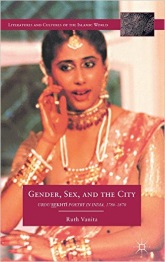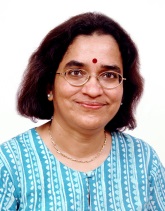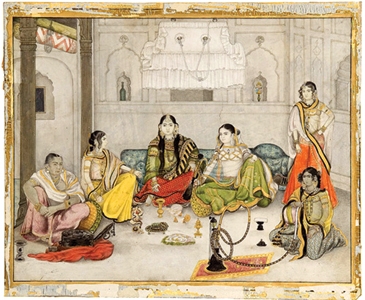Gender, Sex and the City: Urdu Rekhti Poetry in India, 1780-1870
Ruth Vanita
|
|
The title of the recent book by Ruth Vanita, Gender, Sex and the City, evokes the cult American television series Sex and the City, thereby revealing some of its thematic preoccupations. Vanita’s book deals with Urdu rekhti poetry – literary hybrid poetry – written during North India’s golden period, between 1780 and 1870, and predominantly about the city of Lucknow. The author has unearthed forgotten manuscripts, filled in editorial ellipses (rekhti was denounced as obscene and thus heavily censored) and presented some of the poems for the first time. What rekhti poetry and the already mentioned TV series have in common is the female narrator who focuses on urban women, the wit, obsession with aesthetics, fashion, good food and wine, urban entertainment, and above all, love and sexual relationships. Where again the two differ is in the fact that rekhti can be termed Sapphic in the sense that it highlights the female-female sexual desire. The women conventionally addressed their female lovers as du-gana or zanakhi, meaning a female intimate companion, with the first word, as Vanita points out, indicating a double, mirrored self. Thus rekhti verse spills the well-kept secrets of women’s everyday existence, their small temptations and indiscretions, and overflows with the flamboyancy of the ordinary. It ritualizes the mundane and “disturbs well-established binary categories like courtesan/respectable woman, mistress/servant, high/low language, and lover/beloved.” However, its best known exponents, whose work is presented in this book, are male poets with suggestive pen-names: Rangin (Colourful), Insha (Elegant Style), Qais (legendary lover Majnun), Nisbat (Comparison/Betrothal), Jurat (Audacity) and Jan Sahib (Sweetheart). They assumed female identities, thus probably giving the female prefix to the poetic practice itself. The language of rekhti is the so called auraton ki zuban (women’s language), that poets Insha and Rangin, among others, eagerly eavesdropped on and meticulously recorded. It is marked by the bubbling jeux d’esprit, puns and wordplays, humour and mercurialness, innuendos, metaphors, double entendres and nuances. The following verses of Insha hint at the underlying erotic charge of the ambiguous words one lover directed at the other: “I am not quite such an innocent, Madam zanakhi ji / As not to understand what your talk means.” Ruth Vanita adds that “rekhti’s poetic playfulness is not non-serious. It is a manifestation of a world view capable of profound depth but also of lightness, happiness as well as reflection, piety as well as profanity.” This poetry mirrors a cosmopolitan, globalized city, a true melting pot of the time, and reaffirms that urban Indian modernity is not a colonial product as some would like to believe; but moreover that the pre-colonial urban cultures and their way of life were swept away by colonial rule. These urbanities were also performative, artificially constructed by every individual who partook in the city’s ambience, its ‘waters,’ by developing their own unique styles and avatars. The belles and bon vivants of the city lived sans restraint in a culture that lavishly celebrated joie de vivre. Gender was fluid and bendable, and their hybrid and ambiguous relationships are best mirrored in these verses by Insha: “I’ve thought a lot about the course of this friendship / It’s neither straight nor aslant nor crooked nor athwart.” The driving force behind the citizens of Lucknow was compulsive desire and a sense of compelling urgency. Ruth Vanita suggests that this urgency probably originated in the feeling of impending doom in the form of British annexation of Avadh, which finally happened in 1856. Nawabs, knowing they are racing against the clock, didn’t want to leave anything to the East India Company, so they abundantly spent on arts and pleasure like the money was going out of style. One rekhti verse summarizes a Lakhnavi response to the critics of their pleasure-seeking pursuits in this provocative question, “If I’m full of vices, what is it to you?” Frances W. Pritchett writes that “Lucknowi culture is seen as a cultivation of expertise and connoisseurship, an insistence on pushing even minor arts to their furthest limits, a rejection of moderation … in favor of elegance and extravagance.” The economy of North India was flourishing in the early nineteenth century, and could fuel this bustling intellectual and cultural life of which Lucknow was the epicenter. Some looked at all of this with awe, even stupefaction, but Premchand, born some two decades after 1856, was not so easily swayed. In his short story about the fall of Lucknow, Shatranj ke Khilari, he accurately but unfavorably describes the era: “It was the time of Wajid Ali Shah. Lucknow was absorbed in vilasita (sensuality) … If one person arranged music and dance performances, then the next took pleasure only in the intoxication of opium … No one knew what was happening in the world.” In rekhti verse, the city of Lucknow is likened to Indralok populated with fairies, but also with the otherwise unsung workers, vendors and servants, governesses, nursemaids, cooks, bangle sellers and palanquin bearers who all add to the classless mix. Rekhti also abounds in cross-religious references to Hindu pantheon, epics and the Puranas. Veils, bangles, waistbands, bodices, and most regularly, drawstrings (decorative objects back in the day, exposed to sight and bearing heightened erotic connotations), are tirelessly invoked. While ghazals are all about swooning, weeping and unrequited love, Vanita points out, rekhti is down-to-earth and praises the attainable pleasures. One rekhti verse humorously alludes to ghazal conventions that equate love with death: “Oh, oh, I want to die at your hands / But what to do? I can’t find a sword right now.” The notion of unrequited love is likewise countered in some of Insha’s verses that emphasize play and multiplicity in love. Urban spaces, both exterior and interior, feature prominently in rekhti, and are sometimes real, historical places. Rooftops were favored (secret) meeting spots for women, the coverging points of the home and the world. In the following verses by Insha a woman in parda addresses a more boyish one: “Du-gana, you climb to the rooftop in the sun, and fly kites / While my colour fades even in moonlight.” The neighbourhood was the most immediate pleasure zone. In one of his poems, Qais describes a woman’s infatuation with a neighbour, “What a smoking hot flame she was, bu-bu – / That neighbour lady who came to borrow fire,” and even household objects have erotic connotations, “Hair got tangled with hair … / Huqqas broke huqqas and pipes pipes / The base fought the base and water-pipes water-pipes … / Insha, in this pomp and show, my eyes too / Met the eyes of another and fought fiercely.” The women of the city often visited melas, festivals and bazaars, gardens and dargahs. Some places were especially alluring during the rainy season: “Come, let’s go to Qutb Sahib, put up a swing, and swing there / Du-gana! It’s raining wine, this is the month of Sawan.” The ladies also had delicate palates and enjoyed savory dishes on their outings, as Nisbat’s verses recall the “sweet cakes of bread” and “fried piping hot lentil dumplings.” Cosmetics are mentioned in much detail in rekhti (antimony, paan, henna or kajal), as is fashion. Nisbat’s lady notices that “this is the style of an earlier era, madam seamstress,” while Jan Sahib’s denounces her friend’s hairstyle as being out-of-date and Qais’s warns of the ancient danger of stilettos, “I beg you, don’t climb the stairs in high-heeled shoes – / If your foot slips and ankle twists, would that be good?” Invoking the fairies and jinns was a widespread practice among the city ladies, Vanita writes, and séances were treated as highly ritualized social occasions, the language of which seeped into rekhti, as in this Rangin’s verse: “Her talk (is) sorcery…” All of this seems to proclaim that female lives and gatherings were not oppressed by ennui. Moreover, some of them wielded significant political power, for instance, city’s courtesans. They held soirées where men gathered to master social etiquette, Urdu poetry and refinement per se. However, the book illustrates, in the second half of the nineteenth century, by losing the wealthy patrons, the institution of the courtesan was slowly degraded to mere prostitution. Poet Jan Sahib, who composed his verse throughout these political changes, sees rekhti as the symbol of the waning world: “Jan! You are reading rekhti in Lucknow / The nightingale is singing in a deserted garden.” Rekhti poets professed a certain universalism that rested on solid philosophical systems, but mostly on the premise that life is a play and pleasure a worthwhile and honourable pursuit. Their worldview is best reflected in a sort of blessing that Insha dispenses on his readers and listeners: “Enjoy every pleasure and luxury all the time, God willing / May your beauty shine brilliantly, be fairy-faced wherever you go.” Reading this book, one is persistently tempted and teased by all the colourful lovers and friends who are “stepping out of the page” to be played and laughed with, and most of all, enjoyed.
|


 Ruth Vanita
Ruth Vanita Mohammad Saad: Rekhti – Poetry of Subversion
Mohammad Saad: Rekhti – Poetry of Subversion